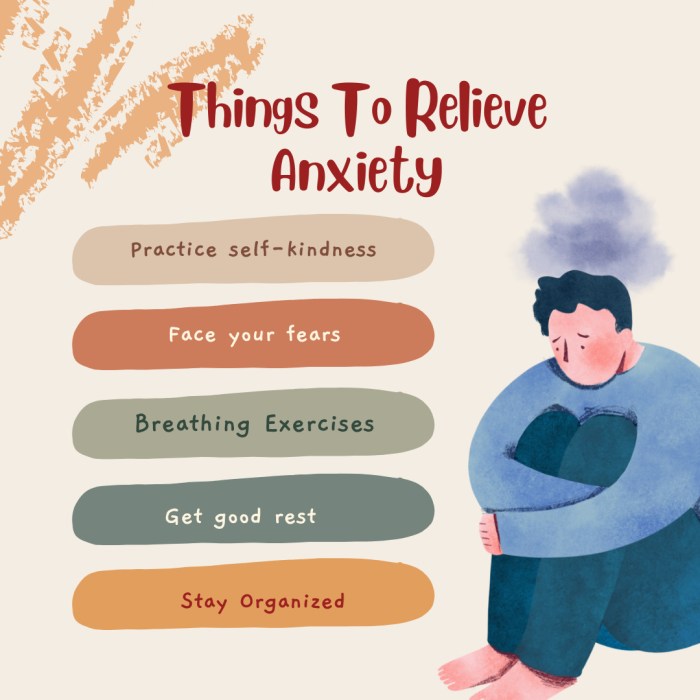Delving into 6 Effective Meditation Exercises to Ease Anxiety, this introduction immerses readers in a unique and compelling narrative, with visual descriptive language style that is both engaging and thought-provoking from the very first sentence.
Embark on a journey through powerful meditation techniques designed to alleviate anxiety and bring peace of mind. From mindfulness practices to deep breathing exercises, discover how these methods can transform your mental well-being.
Introduction to Meditation for Anxiety Relief

Meditation is a practice that involves focusing the mind and eliminating racing thoughts, leading to a sense of calm and inner peace. When it comes to managing anxiety, meditation has been proven to be highly effective in reducing stress levels and promoting emotional well-being.Incorporating meditation into your daily routine can help ease anxiety symptoms by promoting relaxation, mindfulness, and self-awareness.
By taking the time to quiet the mind and focus on the present moment, individuals can learn to manage their anxiety triggers more effectively and cultivate a sense of inner balance.
Benefits of Meditation for Anxiety Relief
- Meditation helps reduce the production of stress hormones like cortisol, leading to a decrease in anxiety levels.
- Regular meditation practice can improve emotional regulation and increase resilience to stressors.
- Studies have shown that mindfulness meditation can lower symptoms of anxiety disorders like generalized anxiety disorder and social anxiety disorder.
- Meditation can enhance self-awareness, allowing individuals to recognize anxious thoughts and emotions and respond to them in a more constructive way.
Mindfulness Meditation Techniques: 6 Effective Meditation Exercises To Ease Anxiety

Mindfulness meditation is a practice that involves focusing your mind on the present moment without judgment. It can help reduce anxiety by allowing you to observe your thoughts and feelings without becoming overwhelmed by them.
Step-by-step Guide to Practice Mindfulness Meditation
- Find a quiet and comfortable place to sit or lie down.
- Close your eyes and take a few deep breaths to center yourself.
- Focus on your breath as it enters and leaves your body, noticing how it feels.
- If your mind starts to wander, gently bring your attention back to your breath without judgment.
- Continue this practice for a few minutes to start, gradually increasing the duration as you feel more comfortable.
Benefits of Focusing on the Present Moment
By focusing on the present moment during mindfulness meditation, you can alleviate anxiety and stress by breaking the cycle of rumination and worry. Instead of dwelling on past events or fearing the future, you learn to accept the current moment as it is, reducing the power of anxious thoughts.
Deep Breathing Exercises

Deep breathing is a powerful tool in calming the nervous system and reducing anxiety levels. By focusing on your breath, you can bring a sense of calm and relaxation to both your mind and body.
Different Deep Breathing Techniques
- Belly Breathing: Place one hand on your chest and the other on your belly. Inhale deeply through your nose, letting your belly rise as you fill your lungs with air. Exhale slowly through your mouth, feeling your belly fall.
- 4-7-8 Technique: Inhale for a count of 4, hold your breath for a count of 7, and exhale for a count of 8. This pattern helps regulate your breathing and calm your nervous system.
- Nadi Shodhana (Alternate Nostril Breathing): Close off one nostril with your thumb and inhale deeply through the other nostril. Switch nostrils and exhale. This technique helps balance the flow of energy in your body.
Benefits of Deep Breathing Exercises
- Reduces Stress Hormones: Deep breathing triggers the body’s relaxation response, reducing the production of stress hormones like cortisol.
- Calms the Nervous System: By focusing on your breath, you can activate the parasympathetic nervous system, which promotes relaxation and reduces anxiety.
- Improves Oxygen Flow: Deep breathing increases oxygen flow to the brain, promoting clarity of thought and a sense of calm.
Visualization Meditation Practices
Visualization meditation is a powerful technique for managing anxiety by engaging the mind in positive imagery. By focusing on calming visuals, you can create a sense of peace and tranquility within yourself. Let’s explore some visualization techniques that can help ease anxiety.
Guided Nature Visualization
- Imagine yourself in a serene natural setting, such as a peaceful forest or a tranquil beach.
- Visualize the sights, sounds, and smells of the environment around you, allowing yourself to fully immerse in the experience.
- Focus on the details of the landscape, from the swaying trees to the gentle waves, and feel a sense of calm wash over you.
Safe Haven Visualization
- Create a mental sanctuary where you feel completely safe and secure.
- Imagine every detail of this safe space, from the colors to the textures, and fill it with comforting elements that bring you peace.
- Visualize yourself surrounded by a protective light that shields you from any worries or anxieties.
Success Visualization
- Picturing yourself accomplishing your goals and overcoming challenges can instill confidence and reduce anxiety.
- Visualize the steps you need to take to achieve success, focusing on each detail and feeling the sense of achievement.
- By visualizing positive outcomes, you can shift your mindset and alleviate stress and anxiety.
Body Scan Meditation for Relaxation
Body scan meditation is a powerful technique that can help release tension and promote relaxation by increasing body awareness and reducing anxiety levels. By systematically focusing on different parts of the body, you can tune into physical sensations and let go of any stress or negative emotions.
How to Perform Body Scan Meditation Effectively
- Find a quiet and comfortable space to lie down or sit comfortably.
- Close your eyes and take a few deep breaths to center yourself.
- Start by bringing your attention to your toes, noticing any sensations without judgment.
- Slowly move your awareness up through each part of your body, from your feet to your head.
- Notice any areas of tension or discomfort and imagine breathing into those areas to release the stress.
- Take your time with each body part, allowing yourself to fully relax and let go of any tension.
- Finish by taking a few more deep breaths and slowly opening your eyes.
Connection Between Body Awareness and Anxiety Reduction
Body scan meditation helps to cultivate a greater sense of body awareness, allowing you to recognize and release physical tension that may be contributing to your anxiety. By regularly practicing this technique, you can learn to tune into your body’s signals, manage stress more effectively, and promote relaxation throughout your daily life.
Loving-Kindness Meditation for Emotional Well-being

Loving-kindness meditation, also known as Metta meditation, is a practice that involves directing feelings of love and compassion towards oneself and others. This form of meditation can have a profound impact on emotional well-being by promoting feelings of kindness, empathy, and connection with others.
Steps to Practice Loving-Kindness Meditation, 6 Effective Meditation Exercises to Ease Anxiety
- Find a quiet and comfortable place to sit or lie down.
- Close your eyes and take a few deep breaths to relax your body and mind.
- Start by focusing on yourself and silently repeat phrases of loving-kindness such as “May I be happy, may I be healthy, may I be safe, may I live with ease.”
- Once you have cultivated feelings of love and compassion towards yourself, gradually extend these feelings towards loved ones, acquaintances, and even those you may have difficulties with.
- Continue to repeat phrases of loving-kindness for each person, wishing them happiness, health, safety, and ease.
- Finally, expand your practice by sending loving-kindness to all beings in the world, wishing for their well-being and happiness.
Cultivating compassion and kindness through loving-kindness meditation can help in managing anxiety by shifting focus away from negative thoughts and emotions towards positive feelings of love and connection with others.
Final Wrap-Up

In conclusion, the realm of meditation offers a sanctuary for those seeking relief from anxiety. By incorporating these 6 effective exercises into your daily routine, you can embark on a path towards inner calm and emotional balance. Embrace the transformative power of meditation and let go of anxiety’s grip on your life.